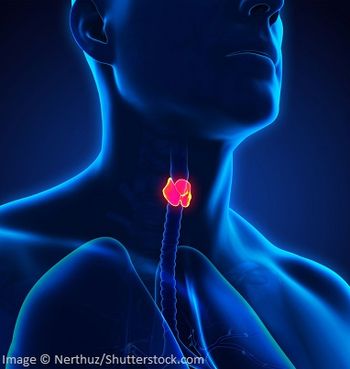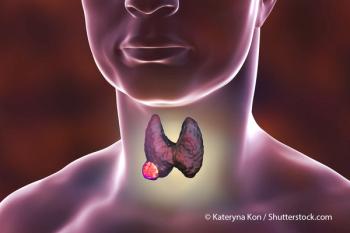
Bioinformatics Analysis Identifies Key Biomarkers
Genetic profiles of thyroid cancer shed light on molecular mechanisms.
Although frequency is on the rise, mortality rates due to thyroid cancer are declining because of earlier diagnosis. Nevertheless, mortality rates vary by thyroid cancer type. In a bid to seek out new therapeutic targets, Liu and co-investigators went on a hunt for biomarkers, detailing results in a study published in the Journal of Cellular Physiology.
“With the help of highâthroughput technologies, including microarrays and RNAâsequencing, the
Liu et al. first downloaded expression profiles of GSE3467, GSE5364, GSE29265 and GSE53157 utilizing the Gene Expression Omnibus (GEO) database, which comprised 97 thyroid cancer samples and 48 samples within normal limits.
After analyzing each dataset, 359 robust DEGs were identified. Of these DEGs, 135 were upregulated and 224 were downregulated. These DEGs were rich in a range of cancer-related functions and pathways, per Gene Ontology (GO) and Kyoto Encyclopaedia of Genes and Genomes (KEGG) pathway enrichments analyses. These analyses were performed using the DAVID and KOBAS online databases, respectively.
Investigators then employed the STRING database to build the protein–protein interaction (PPI) network, followed by modules. The researchers filtered out five hub genes from the PPI network: LPAR5, NMU, FN1, NPY1R, and CXCL12. On the basis of The Cancer Genome Atlas (TCGA) database, expression validation, and survival analysis of these five hub genes was performed, which indicated the robustness of results.
Combined findings from microarrays and so forth can be used to identify biomarkers; to integrate these findings, the RRA method has proven useful. This method is free of interference and enhances the importance of genes ranked. To date, this approach has been usually used in microRNA studies of non-small cell lung cancer, colorectal cancer, nasopharyngeal cancer, hepatocellular cancer, and other cancers. In addition to utilization of the RRA method, per the authors, another strength of the current study was its high power, with a large number of tumor and normal tissues.
Compared with other studies, some overlap in the hub genes existed. For instance, starting with the TCGA database, Tang et al. identified 10 hub genes: NPY, NMU, KNG1, LPAR5, CCR3, SST, PPY, GABBR2, ADCY8, and SAA1, with overlap in LPAR5. Furthermore, starting with four original GEO microarray datasets-GSE3678, GSE3467, GSE33630, and GSE58545-Liang and Sun screened the following genes from the PPI network: BCL2, CCND1, FN1, IRS1, COL1A1, and CXCL12, with overlap in FN1 and CXCL12.
In an exclusive interview with Cancer Network, Peter Oppelt, MD, medical oncologist, Siteman Cancer Center, Assistant Professor of Medicine, Washington University School of Medicine in St. Louis, highlighted the importance of the current study.
“Future therapies will likely have to move beyond targeting VEGF signaling and novel targets need to be found. By identifying new gene alterations in thyroid cancer, Dr. Liu's work may provide the ground work needed to move us towards this goal,” he said.
In a separate interview with Cancer Network, Moran Amit, MD, PhD, Assistant Professor, The University of Texas MD Anderson Cancer Center, Department of Head and Neck Surgery, Houston, provided his thoughts.
“Thyroid cancer treatment is straight forward for most part, however for a subset of patient treatment might be tricky and response can be less predicted,” he said. “What we need is a prediction tool to be able to fine-tune counseling patients and inform therapeutic strategies. Studying multiple databases and validation cohorts, the authors inform us with new set of genomic markers for thyroid cancer. The authors used advanced in-silico and in-vitro approaches to look into tumor samples derived from patients with thyroid cancer.”
He continued, “These data are exciting because they suggest a new set of biomarkers relevant to multiple pathways that are currently investigated as potential targets in cancer therapy, such as immunobiology and cancer metabolism. The authors suggest a novel gene LPAR5 as a marker for survival. While it's exciting to have a novel biomarker for treatment resistant thyroid cancer, time will tell if using the proposed gens as a prognostic marker rises to the top.”
Finally, Jennifer Rui Wang, MD, ScM, Assistant Professor Department of Head and Neck Surgery, The University of Texas MD Anderson Cancer Center, had the following to say about the study.
“Liu et al investigated transcriptomic alterations in thyroid cancers by using publicly available datasets as well as within their own set of 20 patients, identifying differentially expressed genes that may be associated with thyroid cancer development and prognosis,” she said.
“While most studies on genomics of thyroid cancer have focused on somatic mutations, studies like this draw emphasis to examining changes in the transcriptome which has been understudied. The transcriptome captures changes as a result of genetic mutations as well as non-genetic mechanisms, which may have important implications in terms of treatment selection and prognosis.”
References:
Reference: Liu et al. Identification of key genes and pathways of thyroid cancer by integrated bioinformatics analysis. J Cell Physiol. 2019;234:23647–23657.
Newsletter
Stay up to date on recent advances in the multidisciplinary approach to cancer.





